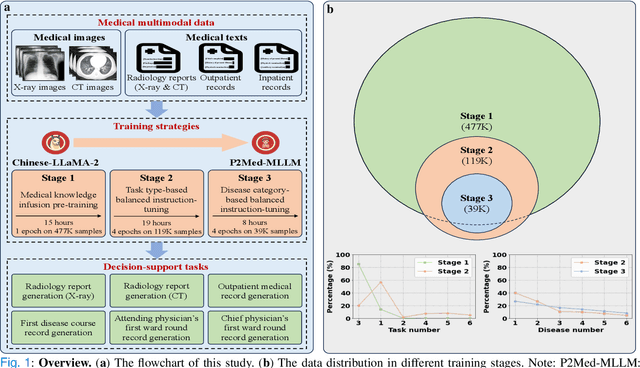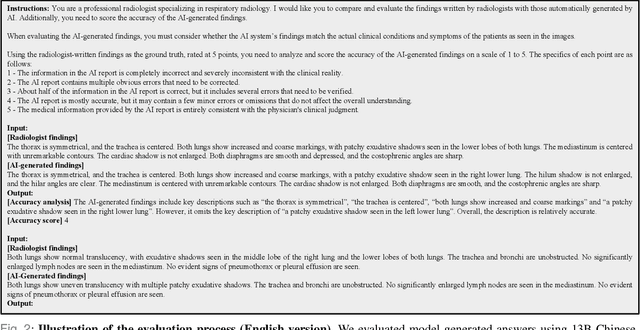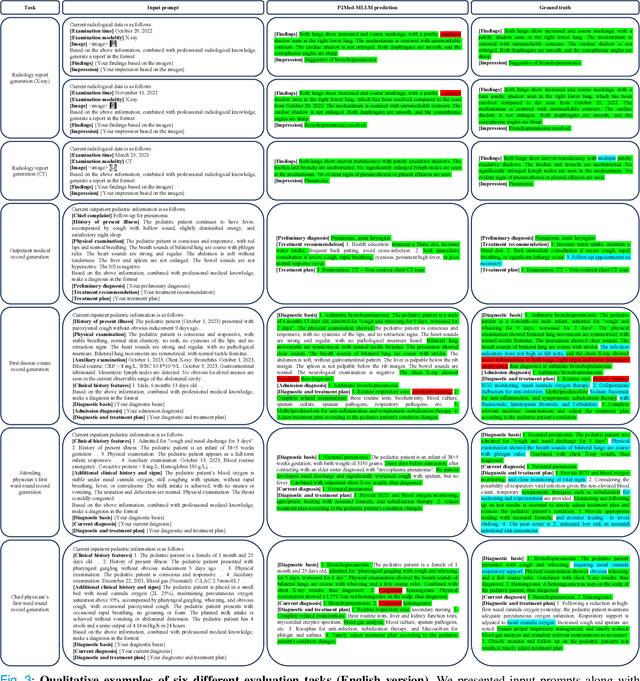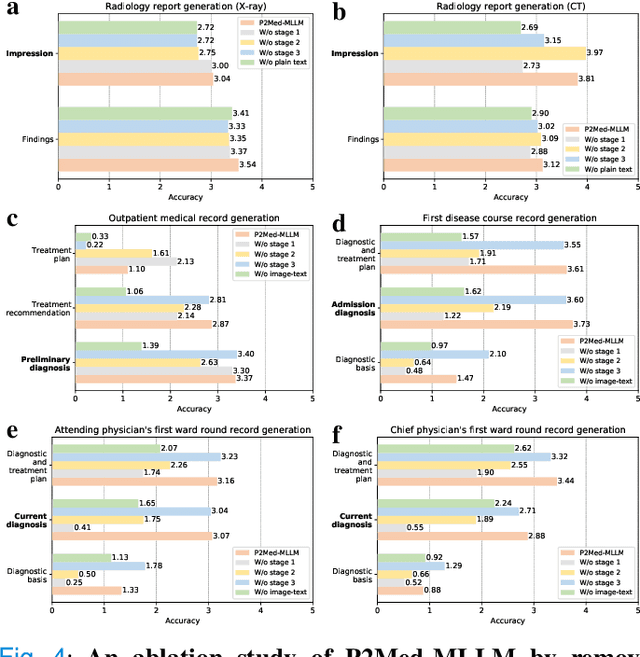Tianhao Cheng
A Survey on Latent Reasoning
Jul 08, 2025Abstract:Large Language Models (LLMs) have demonstrated impressive reasoning capabilities, especially when guided by explicit chain-of-thought (CoT) reasoning that verbalizes intermediate steps. While CoT improves both interpretability and accuracy, its dependence on natural language reasoning limits the model's expressive bandwidth. Latent reasoning tackles this bottleneck by performing multi-step inference entirely in the model's continuous hidden state, eliminating token-level supervision. To advance latent reasoning research, this survey provides a comprehensive overview of the emerging field of latent reasoning. We begin by examining the foundational role of neural network layers as the computational substrate for reasoning, highlighting how hierarchical representations support complex transformations. Next, we explore diverse latent reasoning methodologies, including activation-based recurrence, hidden state propagation, and fine-tuning strategies that compress or internalize explicit reasoning traces. Finally, we discuss advanced paradigms such as infinite-depth latent reasoning via masked diffusion models, which enable globally consistent and reversible reasoning processes. By unifying these perspectives, we aim to clarify the conceptual landscape of latent reasoning and chart future directions for research at the frontier of LLM cognition. An associated GitHub repository collecting the latest papers and repos is available at: https://github.com/multimodal-art-projection/LatentCoT-Horizon/.
Blending Supervised and Reinforcement Fine-Tuning with Prefix Sampling
Jul 02, 2025Abstract:Existing post-training techniques for large language models are broadly categorized into Supervised Fine-Tuning (SFT) and Reinforcement Fine-Tuning (RFT). Each paradigm presents a distinct trade-off: SFT excels at mimicking demonstration data but can lead to problematic generalization as a form of behavior cloning. Conversely, RFT can significantly enhance a model's performance but is prone to learn unexpected behaviors, and its performance is highly sensitive to the initial policy. In this paper, we propose a unified view of these methods and introduce Prefix-RFT, a hybrid approach that synergizes learning from both demonstration and exploration. Using mathematical reasoning problems as a testbed, we empirically demonstrate that Prefix-RFT is both simple and effective. It not only surpasses the performance of standalone SFT and RFT but also outperforms parallel mixed-policy RFT methods. A key advantage is its seamless integration into existing open-source frameworks, requiring only minimal modifications to the standard RFT pipeline. Our analysis highlights the complementary nature of SFT and RFT, and validates that Prefix-RFT effectively harmonizes these two learning paradigms. Furthermore, ablation studies confirm the method's robustness to variations in the quality and quantity of demonstration data. We hope this work offers a new perspective on LLM post-training, suggesting that a unified paradigm that judiciously integrates demonstration and exploration could be a promising direction for future research.
Success is in the Details: Evaluate and Enhance Details Sensitivity of Code LLMs through Counterfactuals
May 20, 2025Abstract:Code Sensitivity refers to the ability of Code LLMs to recognize and respond to details changes in problem descriptions. While current code benchmarks and instruction data focus on difficulty and diversity, sensitivity is overlooked. We first introduce the CTF-Code benchmark, constructed using counterfactual perturbations, minimizing input changes while maximizing output changes. The evaluation shows that many LLMs have a more than 10\% performance drop compared to the original problems. To fully utilize sensitivity, CTF-Instruct, an incremental instruction fine-tuning framework, extends on existing data and uses a selection mechanism to meet the three dimensions of difficulty, diversity, and sensitivity. Experiments show that LLMs fine-tuned with CTF-Instruct data achieve over a 2\% improvement on CTF-Code, and more than a 10\% performance boost on LiveCodeBench, validating the feasibility of enhancing LLMs' sensitivity to improve performance.
Code2Logic: Game-Code-Driven Data Synthesis for Enhancing VLMs General Reasoning
May 20, 2025Abstract:Visual-language Chain-of-Thought (CoT) data resources are relatively scarce compared to text-only counterparts, limiting the improvement of reasoning capabilities in Vision Language Models (VLMs). However, high-quality vision-language reasoning data is expensive and labor-intensive to annotate. To address this issue, we leverage a promising resource: game code, which naturally contains logical structures and state transition processes. Therefore, we propose Code2Logic, a novel game-code-driven approach for multimodal reasoning data synthesis. Our approach leverages Large Language Models (LLMs) to adapt game code, enabling automatic acquisition of reasoning processes and results through code execution. Using the Code2Logic approach, we developed the GameQA dataset to train and evaluate VLMs. GameQA is cost-effective and scalable to produce, challenging for state-of-the-art models, and diverse with 30 games and 158 tasks. Surprisingly, despite training solely on game data, VLMs demonstrated out of domain generalization, specifically Qwen2.5-VL-7B improving performance by 2.33\% across 7 diverse vision-language benchmarks. Our code and dataset are available at https://github.com/tongjingqi/Code2Logic.
Is Compression Really Linear with Code Intelligence?
May 16, 2025Abstract:Understanding the relationship between data compression and the capabilities of Large Language Models (LLMs) is crucial, especially in specialized domains like code intelligence. Prior work posited a linear relationship between compression and general intelligence. However, it overlooked the multifaceted nature of code that encompasses diverse programming languages and tasks, and struggled with fair evaluation of modern Code LLMs. We address this by evaluating a diverse array of open-source Code LLMs on comprehensive multi-language, multi-task code benchmarks. To address the challenge of efficient and fair evaluation of pre-trained LLMs' code intelligence, we introduce \textit{Format Annealing}, a lightweight, transparent training methodology designed to assess the intrinsic capabilities of these pre-trained models equitably. Compression efficacy, measured as bits-per-character (BPC), is determined using a novel, large-scale, and previously unseen code validation set derived from GitHub. Our empirical results reveal a fundamental logarithmic relationship between measured code intelligence and BPC. This finding refines prior hypotheses of linearity, which we suggest are likely observations of the logarithmic curve's tail under specific, limited conditions. Our work provides a more nuanced understanding of compression's role in developing code intelligence and contributes a robust evaluation framework in the code domain.
SuperGPQA: Scaling LLM Evaluation across 285 Graduate Disciplines
Feb 20, 2025Abstract:Large language models (LLMs) have demonstrated remarkable proficiency in mainstream academic disciplines such as mathematics, physics, and computer science. However, human knowledge encompasses over 200 specialized disciplines, far exceeding the scope of existing benchmarks. The capabilities of LLMs in many of these specialized fields-particularly in light industry, agriculture, and service-oriented disciplines-remain inadequately evaluated. To address this gap, we present SuperGPQA, a comprehensive benchmark that evaluates graduate-level knowledge and reasoning capabilities across 285 disciplines. Our benchmark employs a novel Human-LLM collaborative filtering mechanism to eliminate trivial or ambiguous questions through iterative refinement based on both LLM responses and expert feedback. Our experimental results reveal significant room for improvement in the performance of current state-of-the-art LLMs across diverse knowledge domains (e.g., the reasoning-focused model DeepSeek-R1 achieved the highest accuracy of 61.82% on SuperGPQA), highlighting the considerable gap between current model capabilities and artificial general intelligence. Additionally, we present comprehensive insights from our management of a large-scale annotation process, involving over 80 expert annotators and an interactive Human-LLM collaborative system, offering valuable methodological guidance for future research initiatives of comparable scope.
FineMedLM-o1: Enhancing the Medical Reasoning Ability of LLM from Supervised Fine-Tuning to Test-Time Training
Jan 16, 2025Abstract:Recent advancements in large language models (LLMs) have shown promise in medical applications such as disease diagnosis and treatment planning. However, most existing medical LLMs struggle with the advanced reasoning required for complex clinical scenarios, such as differential diagnosis or personalized treatment suggestions. We proposed FineMedLM-o1, which leverages high-quality synthetic medical data and long-form reasoning data for Supervised Fine-Tuning (SFT) and Direct Preference Optimization (DPO), enabling advanced dialogue and deep reasoning capabilities. Additionally, we introduced Test-Time Training (TTT) in the medical domain for the first time, facilitating domain adaptation and ensuring reliable, accurate reasoning. Experimental results demonstrate that FineMedLM-o1 achieves a 23% average performance improvement over prior models on key medical benchmarks. Furthermore, the introduction of TTT provides an additional 14% performance boost, highlighting its effectiveness in enhancing medical reasoning capabilities. To support this process, we also proposed a novel method for synthesizing medical dialogue. Compared to other open-source datasets, our dataset stands out as superior in both quality and complexity. The project and data will be released on GitHub.
OpenCoder: The Open Cookbook for Top-Tier Code Large Language Models
Nov 07, 2024



Abstract:Large language models (LLMs) for code have become indispensable in various domains, including code generation, reasoning tasks and agent systems.While open-access code LLMs are increasingly approaching the performance levels of proprietary models, high-quality code LLMs suitable for rigorous scientific investigation, particularly those with reproducible data processing pipelines and transparent training protocols, remain limited. The scarcity is due to various challenges, including resource constraints, ethical considerations, and the competitive advantages of keeping models advanced. To address the gap, we introduce OpenCoder, a top-tier code LLM that not only achieves performance comparable to leading models but also serves as an ``open cookbook'' for the research community. Unlike most prior efforts, we release not only model weights and inference code, but also the reproducible training data, complete data processing pipeline, rigorous experimental ablation results, and detailed training protocols for open scientific research. Through this comprehensive release, we identify the key ingredients for building a top-tier code LLM: (1) code optimized heuristic rules for data cleaning and methods for data deduplication, (2) recall of text corpus related to code and (3) high-quality synthetic data in both annealing and supervised fine-tuning stages. By offering this level of openness, we aim to broaden access to all aspects of a top-tier code LLM, with OpenCoder serving as both a powerful model and an open foundation to accelerate research, and enable reproducible advancements in code AI.
CT2C-QA: Multimodal Question Answering over Chinese Text, Table and Chart
Oct 28, 2024Abstract:Multimodal Question Answering (MMQA) is crucial as it enables comprehensive understanding and accurate responses by integrating insights from diverse data representations such as tables, charts, and text. Most existing researches in MMQA only focus on two modalities such as image-text QA, table-text QA and chart-text QA, and there remains a notable scarcity in studies that investigate the joint analysis of text, tables, and charts. In this paper, we present C$\text{T}^2$C-QA, a pioneering Chinese reasoning-based QA dataset that includes an extensive collection of text, tables, and charts, meticulously compiled from 200 selectively sourced webpages. Our dataset simulates real webpages and serves as a great test for the capability of the model to analyze and reason with multimodal data, because the answer to a question could appear in various modalities, or even potentially not exist at all. Additionally, we present AED (\textbf{A}llocating, \textbf{E}xpert and \textbf{D}esicion), a multi-agent system implemented through collaborative deployment, information interaction, and collective decision-making among different agents. Specifically, the Assignment Agent is in charge of selecting and activating expert agents, including those proficient in text, tables, and charts. The Decision Agent bears the responsibility of delivering the final verdict, drawing upon the analytical insights provided by these expert agents. We execute a comprehensive analysis, comparing AED with various state-of-the-art models in MMQA, including GPT-4. The experimental outcomes demonstrate that current methodologies, including GPT-4, are yet to meet the benchmarks set by our dataset.
A Medical Multimodal Large Language Model for Pediatric Pneumonia
Sep 04, 2024



Abstract:Pediatric pneumonia is the leading cause of death among children under five years worldwide, imposing a substantial burden on affected families. Currently, there are three significant hurdles in diagnosing and treating pediatric pneumonia. Firstly, pediatric pneumonia shares similar symptoms with other respiratory diseases, making rapid and accurate differential diagnosis challenging. Secondly, primary hospitals often lack sufficient medical resources and experienced doctors. Lastly, providing personalized diagnostic reports and treatment recommendations is labor-intensive and time-consuming. To tackle these challenges, we proposed a Medical Multimodal Large Language Model for Pediatric Pneumonia (P2Med-MLLM). It was capable of handling diverse clinical tasks, such as generating free-text radiology reports and medical records within a unified framework. Specifically, P2Med-MLLM can process both pure text and image-text data, trained on an extensive and large-scale dataset (P2Med-MD), including real clinical information from 163,999 outpatient and 8,684 inpatient cases. This dataset comprised 2D chest X-ray images, 3D chest CT images, corresponding radiology reports, and outpatient and inpatient records. We designed a three-stage training strategy to enable P2Med-MLLM to comprehend medical knowledge and follow instructions for various clinical tasks. To rigorously evaluate P2Med-MLLM's performance, we developed P2Med-MBench, a benchmark consisting of 642 meticulously verified samples by pediatric pulmonology specialists, covering six clinical decision-support tasks and a balanced variety of diseases. The automated scoring results demonstrated the superiority of P2Med-MLLM. This work plays a crucial role in assisting primary care doctors with prompt disease diagnosis and treatment planning, reducing severe symptom mortality rates, and optimizing the allocation of medical resources.
 Add to Chrome
Add to Chrome Add to Firefox
Add to Firefox Add to Edge
Add to Edge